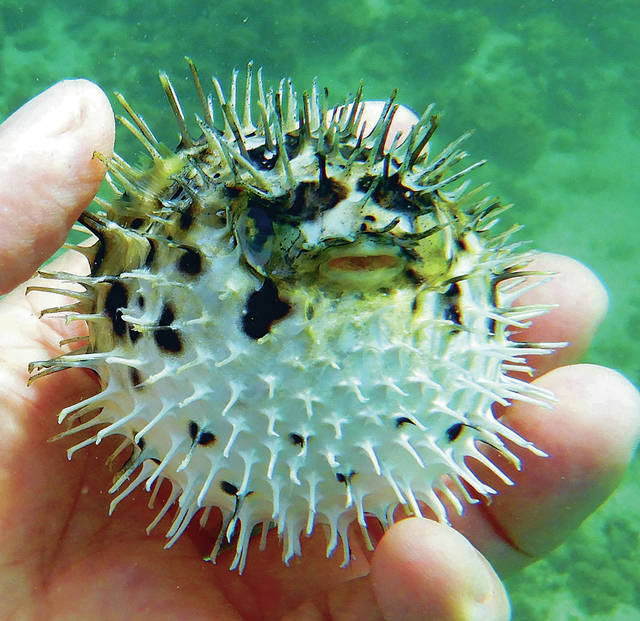Published in the Ocean Watch column, Honolulu Star-Advertiser © Susan Scott
July 14, 2018
While snorkeling with a friend visiting from Canada, I spotted a tiny porcupine pufferfish resting on the ocean floor in about 6 feet of water. I pointed to it, but because Chris didn’t see the fish camouflaged against its rocky background, I dived down to point closer.
At that, the baby puffer shot into a shallow hole of a nearby coral head and inflated into a bristly ball. I hadn’t planned on handling the fish, but in its immobile state it was easy for me to pick it up.
Pufferfish get their name from taking water or, if they’re at the surface, air into their bodies, making them too large to fit in a fish predator’s mouth. Porcupine pufferfish have an additional defense, or three, to be precise. As their name implies, sharp spikes, which normally lie flat against the body, stick out when the fish inflates, turning it into a living pin cushion.
 The author holds a porcupine pufferfish, Diodon holocanthus.
The author holds a porcupine pufferfish, Diodon holocanthus.
©2018 Susan Scott
A downside of this defense is that if a predator’s jaws open wide enough, the blown-up fish can get wedged in the mouth or throat of the hunter. Then it’s curtains for both predator and prey. People have found dead porcupine pufferfish in the throats of dead marlins, jacks, turtles and sharks.
But not all sharks. Tiger sharks are apparently undaunted by the spines on porcupine pufferfish or by the poison they carry in their bodies. The poison, called tetrodotoxin, blocks nerve impulses, causing paralysis in most species. Some snails, crabs and sharks, however, have nerve pathways that are unaffected by this poison.
Pufferfish get their potent poison from bacteria living in something the fish eat. The fish stores the toxin in its skin, liver, intestines and gonads, making some people believe that if cleaned properly, the flesh, called fugu in Japanese, is safe to eat.
Chris knew the fugu story, and as I photographed our little porcupine pufferfish, he said, “Is it safe to hold barehanded like that?”
Although puffers can take off a finger with their guillotinelike teeth, I thought it was safe to hold the little fish gently by the sides. I won’t do it again.
The journal Clinical Toxicology reported in 2005 that after a porcupine pufferfish died in a Dutch aquarium, the curator performed a necropsy to check the cause of death. During the exam, three or four of the fish’s spines punctured his glove and stuck his finger.
The man lived, but over several hours numbness spread from the finger to his arm, shoulder and back, accompanied by dizziness. It took three days to recover.
With their big eyes, smiley mouths, flappy fins and balloony bodies, porcupine pufferfish could be one of Pixar’s cute creations.
But like baby Jack-Jack in that studio’s movie “Incredibles 2” (highly recommended), these little darlings have superpowers. Best not to upset them.